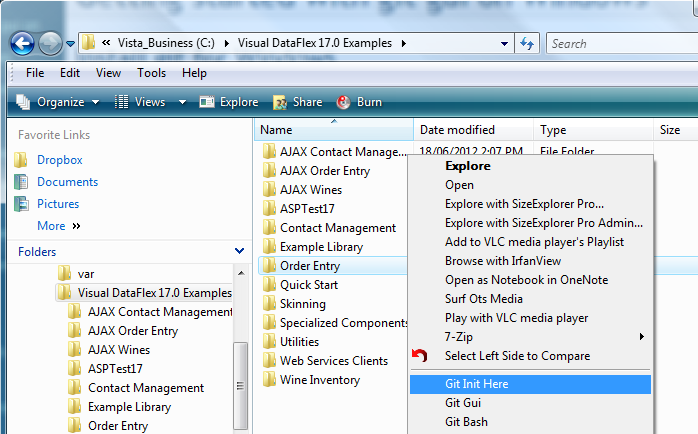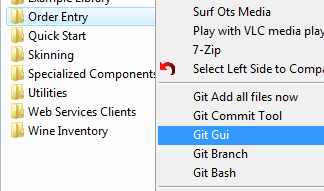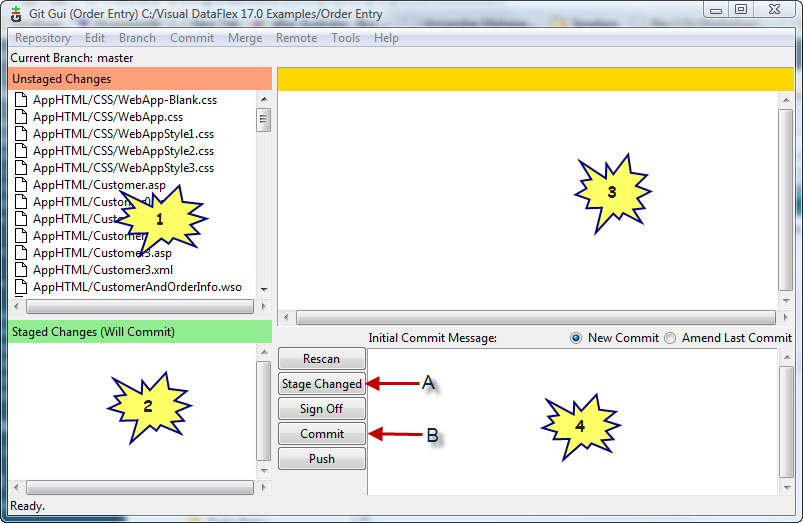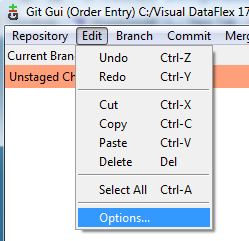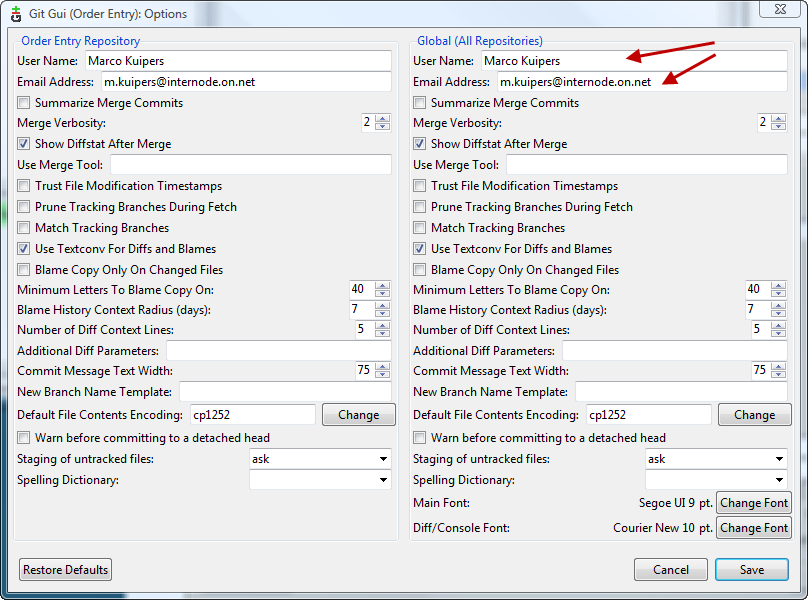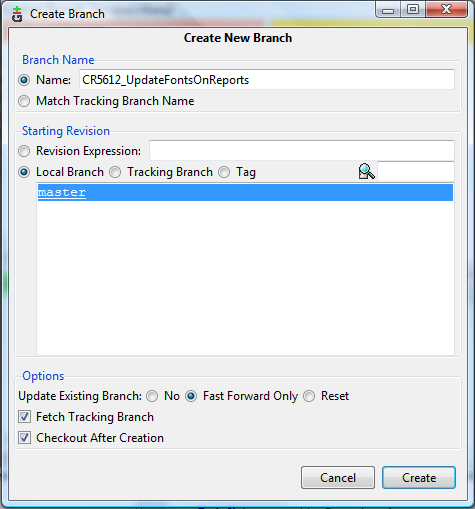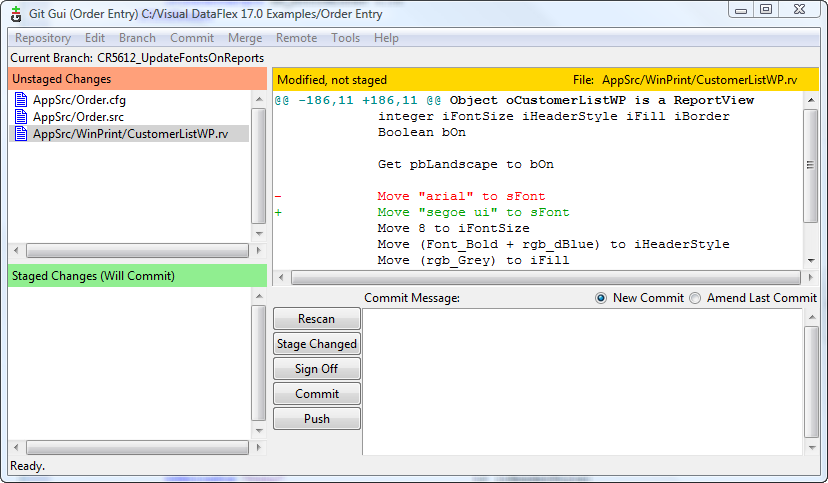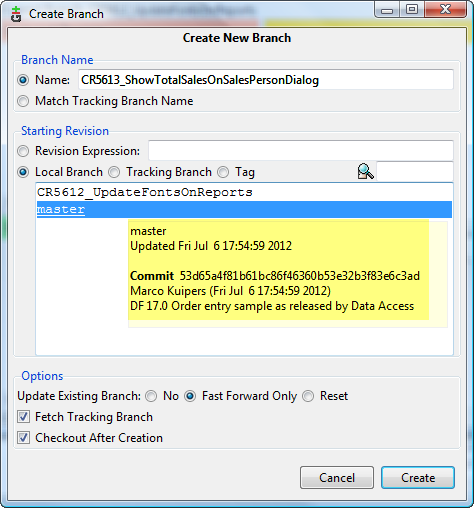Using GIT for Dataflex Development: Difference between revisions
| Line 102: | Line 102: | ||
You noticed that the commit was really quick, and all panels are blank. You have just created a new repository, told GIT what files to ignore, and committed all other files into the repository. | You noticed that the commit was really quick, and all panels are blank. You have just created a new repository, told GIT what files to ignore, and committed all other files into the repository. | ||
== Setting up the author in GIT == | |||
When you commit, GIT keeps track of not only the changes, but also of the Author of the changes. In the above initial commit, we did not set this and as DAW is the author this did not really matter, but changed from now on, should have yourself as the author. | |||
To set the Author select menu Edit – Options. | |||
[[File:UsingGitforVdfDev_image005.png]] | |||
As you can see there are many settings you can do. For now just set the Username and email address as indicated below with the arrows. | |||
[[File:UsingGitforVdfDev_image006.png]] | |||
== Making changes and revert back == | |||
We have our safe initial commit so we can make changes to our hearts content. | |||
Open the Order Entry.sws. Let’s say you want to add the container3D around the objects in the customer view to make it consistent with the other views in this workspace. So I selected in the Design view the Customer Number and Name form, as well as the dbTabDialog. Did Cut, dragged a Container3D from the palette, made it big enough, Pasted the objects back in (while Container3D was selected) and resized the container holding CTRL key to make sure it does not resize the objects. Then I compiled the projects and confirmed all was working. | |||
Notice that I did NOT have to checkout any files! | |||
So when happy with the changes, switch back to Git Gui (Alt+Tab if you leave it running), and do a Rescan by clicking on the button or F5. | |||
Two files are loaded in the Unstaged Changes. As you select the filename you see the changed lines in the third panel. | |||
In this example we have no interest in committing any changes and basically want to lose all uncommitted changes. | |||
From the menu select Branch-Reset. A warning dialog will indicate that you indeed will lose all uncommitted changes. Select Yes. | |||
Switch back to VDF Studio and notice that the customer view is back to what it was. | |||
Now hold-on you might say, why is this in the branch menu, I would not have looked there... When we look a bit further at branching I promise it will make more sense. If impatience; the short answer is that the master is also a branch. | |||
== Creating a branch and making changes == | |||
As a developer you should not create changes direct in the master branch. Instead you should create a branch specific to the change you want to make (topic branch), and then when you decide to keep the change, merge the topic branch into the master (or even better in a release branch). | |||
There are two methods of organising the topic branches. The first way is as sibblings, the other way is consecutive. This document starts with the sibbling way. | |||
Let’s create a new branch; switch back to Git gui and select menu: branch – create to open the following dialog; | |||
[[File:UsingGitforVdfDev_image007.png]] | |||
I’ve entered a branch name. Notice that the dialog does not allow you to insert spaces, so use Mixed case notation. Use a naming that refers to an ID in your change request system so use something like “CR5612_UpdateFontsOnReports “. | |||
Notice that the starting revision is ‘master’ but don’t worry about this too much, otherwise you might think it’s more complex than it is. | |||
So click on Create after you entered the name. The dialog changes and all you are left in is the message above the Unstaged Changes panel showing the current branch. | |||
[[File:UsingGitforVdfDev_image008.png]] | |||
Make some changes like commenting out the Crystal reports to save compile time (Includes and menu’s). And replace in CustomerListWP.rv the ‘arial’ font to ‘Segoe UI’. | |||
Compile the project and see how much better the report looks. | |||
Switch back to Git Gui and do a Rescan. | |||
[[File:UsingGitforVdfDev_image009.png]] | |||
You see the three changed files, and at the right the line old and new line. | |||
Let’s assume that this is all the change you want to do for now. The work is not fully done, as you want to change the font on all the reports, but need to attend to another change you want in your project. | |||
So you stage and commit these changes into this branch. Click ‘Stage Changed’ button (or Ctrl+I), enter a commit message eg ‘Changed first report and removed crystal reports’. Click ‘Commit’ (or Ctrl+Enter). | |||
The next change you want to make is not related to the above change. So you create a new topic branch. You’ll soon found that for each individual programming request you want to create an own topic branch. | |||
But take care when creating the new branch; you want to create this from the master. So in the create branch dialog (Menu Branch-Create), you want to select the master as the Starting revision local branch; | |||
[[File:UsingGitforVdfDev_image010.png]] | |||
''I use the name ‘Topic branch’. This is not a name used in GIT itself, but it is used in the GIT documentation to refer to a branch created for the purpose of creating, updating or removal of a specific feature.'' | |||
[[File:UsingGitforVdfDev_image011.png]] | |||
Hovering over the branch names shows some information regarding the branch, which for the sake of this document highlighted in a green box. | |||
When you click create, you see that the Current Branch is changed to the newly created one. | |||
[[File:UsingGitforVdfDev_image012.png]] | |||
As you selected the master to be the starting revision, you will also find that when switching back to the VDF Studio, the state of source code is back to what it was when we committed the master. This might worry you but this is a good thing. | |||
Please confirm that the Crystal reports are back and the font is also back to arial. | |||
''If you made a mistake and did not base the new branch on master, just switch away from the new branch with Branch-Checkout and select master. Then do menu Branch-delete and select the wrongly created branch. Once deleted create the new branch again, but this time based on the master.'' | |||
Make a change like adding the Total sales to the Sales Person entry view. In this revision we just calculate on the spot, but we might later add a field for it; | |||
[[File:UsingGitforVdfDev_image013.png]] | |||
I inserted ‘Use for_all.pkg’ at the top of the SalesP.vw code and the code below just before the End_object of the oContainer1; | |||
<nowiki> | |||
// This only works from VDF 17.0 where Refresh is also send to containers | |||
Procedure Refresh Integer eMode | |||
Send CalculateTotalSales to oTotalSalesForm | |||
End_Procedure | |||
Object oTotalSalesForm is a Form | |||
Set Size to 13 44 | |||
Set Location to 4 182 | |||
Set Form_Datatype to Mask_Currency_Window | |||
Set Enabled_State to False | |||
Set Form_Mask to "$,0." | |||
Set Label to 'Total sales:' | |||
Set Label_Col_Offset to 2 | |||
Set Label_Justification_Mode to jMode_Right | |||
Procedure CalculateTotalSales | |||
Number nTotalSales | |||
Open OrderHea | |||
For_All OrderHea by 0 | |||
Constrain OrderHea Relates to SalesP | |||
do | |||
Add OrderHea.Order_Total to nTotalSales | |||
End_For_All | |||
Set Value to nTotalSales | |||
End_Procedure | |||
End_Object | |||
</nowiki> | |||
Switch back to Git Gui and do a rescan (F5). You see that SalesP.vw and probably order.cfg are changed. | |||
If you are happy with the changes, then Stage and commit them. | |||
Revision as of 07:50, 6 November 2012
Why Version control
Before we jump into GIT in specific, it is important to mention some reasons why developers are more productive when using version control;
- We can keeping track of multiple versions deployed
- Multiple developers can be working on same project
- It is helpful with code checks for auditing or training
- A proper change log of each change is maintained
- We can locate changes for one feature/fix across a number of changed files
- The code is in a safe location, in case of lost hardware
- We can find when a located bug introduced, so you can see what clients are effected
It can be tough when you are looking at a piece of code, not knowing when/how it’s used. But when you can run a version control tool, which shows exactly when those lines were added, by who and with what description, it makes it so much easier to decide what to do with that piece of unknown code, whether it’s retiring it, refactoring, documenting or just leave it as it is. Another good reason that warrants its own paragraph is when you are developing using Agile sprints/iterations. Oversimplified, you determine a list of features you or your team are going to implement in order of priority, but your iteration is timeboxed to eg 4 weeks. This means that after 4 weeks all approved and tested code stays in the product and the features that did not make it in full or are not fully tested and or approved, are to be taken out and used for the next sprint/iteration. This warrants for a good use of version control, where each feature can very easy be isolated from the packaged software.
Types of version control tools
Version control is a way of work, not a tool itself. There are many version control systems, some are more suitable for the VDF development cycle then others. We can identify the following types. Historical version control was done by directory backups e.g. by using zip and file naming. The result is many near identical copies. It also requires a lot of self discipline. Centralised version control has been very popular for years, where you have one centralised server and many remote clients. Examples are CVS, Subversion, Vault, Visual Source Safe and Team Foundation Server. These work very well when you are connected to the server. When not connected these are not giving much assistance. Distributed version control is the latest and most popular peer to peer version control tool. Examples are Mercurial (hg), GIT, BitKeeper etc. This white paper focuses on the last category the distributed version control, with GIT in particular. If you are currently using a Centralised version control, you might be interested in the following list of major changes with the Distributed flavour;
- No access to a server is required, the distributed VC has a local repository that gets synch’ed with a remote (central or peer to peer) repository when it can but can work fine on its own.
- Each developer has its own repository local to their working directory
- No file checkout is required, just start changing the files
- You can stage a number of files, so multiple files can be part of one commit (maintaining the relationship of the changes in the files)
- You can optionally stage only a couple of changed lines in a file (if more changes are made then you want to stage).
- You commit the staged changes with a comment
- You push and pull changes between the local and remote repositories
- Branching used to be hard and therefore hardly used. Now really simple.
- But commit is local, so developers have to do a push to remote to make the change visible for other developers to do a clone/pull from remote
Installing and using GIT
Enough theory, we’ll now show how it’s done. GIT is very small and easy to uninstall later if you decide to do so, therefore I strongly suggest you just follow these steps and perform these yourself while reading this white paper.
Download and install GIT-Gui
Navigate your browser to http://git-scm.com/downloads and download the latest windows version (at time of writing 1.8.0 and about 15Mb in size). Install on your machine, I recommend keeping the installer suggested components, and suggested ‘Adjusting of PATH environment’. The latter helps when creating menu’s in VDF Studio. The ‘Configuring the line ending conversions’, leave for VDF development as checkout as-is, commit as-is.
Creating your first repository
Let’s create a GIT repository of the Visual Dataflex example Order Entry workspace. This workspace always is clean when VDF is installed but in my case, full of test and other changed code after a while. Being able to go back to the original version seems like a good idea for a first repository.
Start with navigate to and select the workspace directory then use the right click (short cut) menu, and select ‘Git Init Here’ as below.
The Git Init takes about a second. In this second it initialised a local repository in this work directory. You find that a subsequent right mouse click on the same directory now shows a different short cut menu;
 Inside the Order Entry directory you see a new hidden directory ‘.git’. This directory contains the whole local repository. So if you would delete this, the repository is gone.
Inside the Order Entry directory you see a new hidden directory ‘.git’. This directory contains the whole local repository. So if you would delete this, the repository is gone.
Although the repository is created, it has not added any of our files. For this to happen we need to stage the files and then commit. We do this in the following steps;
Go back to the workspace directory and select ‘Git Gui’ from the shortcut menu on the Order Entry directory.
Git Gui will start like below
Panel 1 shows all files that are detected to differ from the repository. As the repository is empty, this means this list contains all files. Clicking on a file name (not the icon) shows in panel 3 the changes compared with the repository version
Panel 2 has the files that you have indicated you want to stage for commit. Clicking on the icon of a file in Panel 1, shifts the file from Panel 1 ‘Unstaged Changes’ to panel 2 ‘Staged Changes’.
If this starts to sound all too complicated bare with me, it is really not that hard and there are very good reasons for doing the staging this way
When you look at the files in Panel 1, the Unstaged Changes, you find that it has a number of files you do not want to track such as IDESrc/Workspace.loc, possibly files in the data directory etc.
We can teach GIT what files to ignore by placing a file called .gitignore in the workspace directory. The content of the file is;
#Exclude the following files for Visual DataFlex Projects #################################### programs/*.exe programs/*.dbg programs/*.exe.manifest programs/webapp.log appsrc/*.dep appsrc/*.fld appsrc/*.pbg appsrc/*.pdp appsrc/*.pkd appsrc/*.prp appsrc/*.err data/*.cch ddsrc/*.bak idesrc/studiometadata.mtd idesrc/workspace.loc vssver2.scc nppbackup #personal preference #################################### appsrc/*.prn idesrc/*.dsk
So create this file in notepad, insert the above content and save with filename’.gitignore’ as sibling next to the ‘Order Entry.sws’ file.
If you kept Git Gui open, use the ‘Rescan’ button (or F5 key) and confirm that the unwanted files are no longer shown in the list of Unstaged changes.
Ok, now it’s time to stage all not to be ignored files. You can either select each file in Panel 1, by clicking its icon, use the shift key to select multiple and use Ctrl+T Stage to commit, or click ‘Stage changed’ button (that I marked with ‘A’ in the screenshot).
Now enter the Initial Commit Message like ‘VDF 17.0 Order entry sample as released by Data Access’. And click the ‘Commit’ button (marked with ‘B’ in my screenshot).
You noticed that the commit was really quick, and all panels are blank. You have just created a new repository, told GIT what files to ignore, and committed all other files into the repository.
Setting up the author in GIT
When you commit, GIT keeps track of not only the changes, but also of the Author of the changes. In the above initial commit, we did not set this and as DAW is the author this did not really matter, but changed from now on, should have yourself as the author.
To set the Author select menu Edit – Options.
As you can see there are many settings you can do. For now just set the Username and email address as indicated below with the arrows.
Making changes and revert back
We have our safe initial commit so we can make changes to our hearts content.
Open the Order Entry.sws. Let’s say you want to add the container3D around the objects in the customer view to make it consistent with the other views in this workspace. So I selected in the Design view the Customer Number and Name form, as well as the dbTabDialog. Did Cut, dragged a Container3D from the palette, made it big enough, Pasted the objects back in (while Container3D was selected) and resized the container holding CTRL key to make sure it does not resize the objects. Then I compiled the projects and confirmed all was working.
Notice that I did NOT have to checkout any files!
So when happy with the changes, switch back to Git Gui (Alt+Tab if you leave it running), and do a Rescan by clicking on the button or F5.
Two files are loaded in the Unstaged Changes. As you select the filename you see the changed lines in the third panel.
In this example we have no interest in committing any changes and basically want to lose all uncommitted changes.
From the menu select Branch-Reset. A warning dialog will indicate that you indeed will lose all uncommitted changes. Select Yes.
Switch back to VDF Studio and notice that the customer view is back to what it was.
Now hold-on you might say, why is this in the branch menu, I would not have looked there... When we look a bit further at branching I promise it will make more sense. If impatience; the short answer is that the master is also a branch.
Creating a branch and making changes
As a developer you should not create changes direct in the master branch. Instead you should create a branch specific to the change you want to make (topic branch), and then when you decide to keep the change, merge the topic branch into the master (or even better in a release branch).
There are two methods of organising the topic branches. The first way is as sibblings, the other way is consecutive. This document starts with the sibbling way.
Let’s create a new branch; switch back to Git gui and select menu: branch – create to open the following dialog;
I’ve entered a branch name. Notice that the dialog does not allow you to insert spaces, so use Mixed case notation. Use a naming that refers to an ID in your change request system so use something like “CR5612_UpdateFontsOnReports “.
Notice that the starting revision is ‘master’ but don’t worry about this too much, otherwise you might think it’s more complex than it is.
So click on Create after you entered the name. The dialog changes and all you are left in is the message above the Unstaged Changes panel showing the current branch.
Make some changes like commenting out the Crystal reports to save compile time (Includes and menu’s). And replace in CustomerListWP.rv the ‘arial’ font to ‘Segoe UI’.
Compile the project and see how much better the report looks.
Switch back to Git Gui and do a Rescan.
You see the three changed files, and at the right the line old and new line.
Let’s assume that this is all the change you want to do for now. The work is not fully done, as you want to change the font on all the reports, but need to attend to another change you want in your project.
So you stage and commit these changes into this branch. Click ‘Stage Changed’ button (or Ctrl+I), enter a commit message eg ‘Changed first report and removed crystal reports’. Click ‘Commit’ (or Ctrl+Enter).
The next change you want to make is not related to the above change. So you create a new topic branch. You’ll soon found that for each individual programming request you want to create an own topic branch.
But take care when creating the new branch; you want to create this from the master. So in the create branch dialog (Menu Branch-Create), you want to select the master as the Starting revision local branch;
I use the name ‘Topic branch’. This is not a name used in GIT itself, but it is used in the GIT documentation to refer to a branch created for the purpose of creating, updating or removal of a specific feature.
Hovering over the branch names shows some information regarding the branch, which for the sake of this document highlighted in a green box.
When you click create, you see that the Current Branch is changed to the newly created one.
As you selected the master to be the starting revision, you will also find that when switching back to the VDF Studio, the state of source code is back to what it was when we committed the master. This might worry you but this is a good thing.
Please confirm that the Crystal reports are back and the font is also back to arial.
If you made a mistake and did not base the new branch on master, just switch away from the new branch with Branch-Checkout and select master. Then do menu Branch-delete and select the wrongly created branch. Once deleted create the new branch again, but this time based on the master.
Make a change like adding the Total sales to the Sales Person entry view. In this revision we just calculate on the spot, but we might later add a field for it;
I inserted ‘Use for_all.pkg’ at the top of the SalesP.vw code and the code below just before the End_object of the oContainer1;
// This only works from VDF 17.0 where Refresh is also send to containers
Procedure Refresh Integer eMode
Send CalculateTotalSales to oTotalSalesForm
End_Procedure
Object oTotalSalesForm is a Form
Set Size to 13 44
Set Location to 4 182
Set Form_Datatype to Mask_Currency_Window
Set Enabled_State to False
Set Form_Mask to "$,0."
Set Label to 'Total sales:'
Set Label_Col_Offset to 2
Set Label_Justification_Mode to jMode_Right
Procedure CalculateTotalSales
Number nTotalSales
Open OrderHea
For_All OrderHea by 0
Constrain OrderHea Relates to SalesP
do
Add OrderHea.Order_Total to nTotalSales
End_For_All
Set Value to nTotalSales
End_Procedure
End_Object
Switch back to Git Gui and do a rescan (F5). You see that SalesP.vw and probably order.cfg are changed.
If you are happy with the changes, then Stage and commit them.
